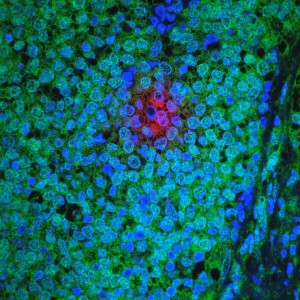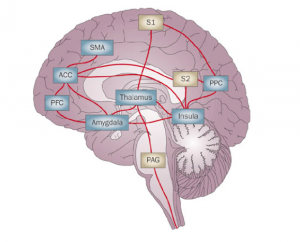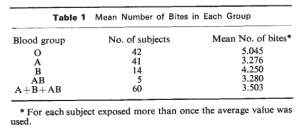When you look at it, your brain is in a series of complex change: gazing makes your brain secrets a large amount of oxytocin that makes you get closer. At the same time, the oxytocin in its brain is increasing, making the same impact…
“It”I mention here is dog. Journal“Science”has published a study in recent year, that points out that gazing behavior between owners and dogs produce a positive feedback of oxytocin secretion, which makes dogs become human’s best friends. Wolves, who rarely engage in eye contact with their human handlers, seem resistant to this effect. Hence, oxytocin not only become the connection of people’s love, but also produce the love over species.
What is oxytocin?
In 1906, the renowned British physiologist Sir Henry H Dale discovered a type of hormone facilitating uterine contractions. He named it “oxytocin”. In 1909, the clinical potential of Dale’s seminal findings on oxytocin was realized by the celebrated British obstetrician and gynecologist William Blair Bell. Bell claimed that oxytocin could not only rapidly facilitated uterine contractions to assist in fetal delivery, but also prevented postpartum hemorrhage, and provided considerable relief for male and female patients suffering from severe constipation. In the early 1950s, American biochemist Vincent du Vigneaud identified the nine-amino acid sequence of oxytocin, and synthesized this polypeptide hormone for the first time. This work represented the first characterization and synthesis of a neuropeptide and resulted in a Nobel Prize in Chemistry for du Vigneaud in 1955. (More details about oxytocin in http://jop.sagepub.com/content/27/3/231.full)
Oxytocin is normally produced by the paraventricular nucleus of the hypothalamus and released by the posterior pituitary. Both male and female can secrete oxytocin. After releasing, a part of oxytocin reaches periphery tissue through blood circulation, and the rest passing hemato encephalic barrier, enters the central nervous system and functions as a neurotransmitter.
Oxytocin’s functions
Oxytocin influence several aspects of individual behaviors. The studies in early stage mostly focus on its impact of maternal behavior. A study shows that there is a positive correlation between oxytocin throughout pregnancy and maternal-fetal attachment. In other words, if mother has high levels of oxytocin, she would do more intimate behaviors, such as hug. Besides this, oxytocin affects couple relationship. Because the couples who absorb oxytocin have less conflicts and more positive communications. Additionally, previous studies have shown oxytocin increases trust among people.
It is very interesting that oxytocin can also affect some animals.  Microtus ochrogaster release oxytocin that stimulates dopamine during mating, so they can maintain monogamy. However, microtus montanus, which has similar genes with microtus orhrogaster, doesn’t release oxytocin and dopamine, so this species maintains group marriage.
Microtus ochrogaster release oxytocin that stimulates dopamine during mating, so they can maintain monogamy. However, microtus montanus, which has similar genes with microtus orhrogaster, doesn’t release oxytocin and dopamine, so this species maintains group marriage.
 Then we go back to the study at Azabu University in Sagamihara, Japan, which was published in “Science”. The result finds that gazing from pet dogs made high levels of oxytocin contents in owner’s urine samples, and vice versa. Therefore, the relationship between owners and pet dogs becomes closer and closer. This positive feedback loop, he says, may have played a critical role in dog domestication. In this study, the dogs were males and females, spayed, neutered and intact. The breeds included Golden retrievers, standard poodles, miniature Dachshunds, miniature Schnauzers, a Jack Russell Terrier, and two mixed breed. So the samples are very representative. And I think the conclusion is convincing.
Then we go back to the study at Azabu University in Sagamihara, Japan, which was published in “Science”. The result finds that gazing from pet dogs made high levels of oxytocin contents in owner’s urine samples, and vice versa. Therefore, the relationship between owners and pet dogs becomes closer and closer. This positive feedback loop, he says, may have played a critical role in dog domestication. In this study, the dogs were males and females, spayed, neutered and intact. The breeds included Golden retrievers, standard poodles, miniature Dachshunds, miniature Schnauzers, a Jack Russell Terrier, and two mixed breed. So the samples are very representative. And I think the conclusion is convincing.
So that human and dogs become good friend is not a coincidence. What’s more, in my opinion, my dog is as my “fur baby”, do you?
Source1 Source2 Source3 Source4 Source5 Source6 Source7 Source8

 As we know, our daily diet can affect our health. Today, vegetable, green food becomes the synonym of healthy food. People start to modify their diets that eat more vegetables and less meat. What’s more, many choose to become vegetarians. Approximately six to eight million adults in the United States eat no meat, fish, or poultry, according to a Harris Interactive poll commissioned by the Vegetarian Resource Group, a nonprofit organization that disseminates information about vegetarianism. Several million more have eliminated red meat but still eat chicken or fish. About two million have become vegans, forgoing not only animal flesh but also animal-based products such as milk, cheese, eggs, and gelatin.
As we know, our daily diet can affect our health. Today, vegetable, green food becomes the synonym of healthy food. People start to modify their diets that eat more vegetables and less meat. What’s more, many choose to become vegetarians. Approximately six to eight million adults in the United States eat no meat, fish, or poultry, according to a Harris Interactive poll commissioned by the Vegetarian Resource Group, a nonprofit organization that disseminates information about vegetarianism. Several million more have eliminated red meat but still eat chicken or fish. About two million have become vegans, forgoing not only animal flesh but also animal-based products such as milk, cheese, eggs, and gelatin. What’s more, a vegetarian diet can be lacking in certain key nutrients, if not well planned. For instance, vegetarian should eat more to maintain healthy and get enough protein. Vegetarians and vegans also need to prioritize their intake of iron, calcium, vitamin B12, and zinc.
What’s more, a vegetarian diet can be lacking in certain key nutrients, if not well planned. For instance, vegetarian should eat more to maintain healthy and get enough protein. Vegetarians and vegans also need to prioritize their intake of iron, calcium, vitamin B12, and zinc. 
 haze. So, can haze cause seasonal affective disorder, and then induce suicide? Vice professor Jie Zhong in Psychology of Peking University said that although melatonin levels are related to depression, this kind of influence usually exist in the high latitude regions having polar daylight and polar night, such as Russia, Norway and Denmark. Therefore, he said that haze is just an excuse for depression. From my perspective, this conclusion has no any evidence or experiment to support, so it is not convincing.
haze. So, can haze cause seasonal affective disorder, and then induce suicide? Vice professor Jie Zhong in Psychology of Peking University said that although melatonin levels are related to depression, this kind of influence usually exist in the high latitude regions having polar daylight and polar night, such as Russia, Norway and Denmark. Therefore, he said that haze is just an excuse for depression. From my perspective, this conclusion has no any evidence or experiment to support, so it is not convincing.
 Many factors can influence our heights.( For example, the nutrition we intake in childhood, the amount of foods we consumed in childhood can influence heights.) Therefore we have several possible explanation for the correlation between heights and cancer risks. Growth factor is a circulating level of protein which is influenced by exercises, stress, body mass index and nutrition. It is associated with both increased height and cancer risk. So taller people (while young) are exposed to higher levels of growth factors, which could possibly promote cancer development.
Many factors can influence our heights.( For example, the nutrition we intake in childhood, the amount of foods we consumed in childhood can influence heights.) Therefore we have several possible explanation for the correlation between heights and cancer risks. Growth factor is a circulating level of protein which is influenced by exercises, stress, body mass index and nutrition. It is associated with both increased height and cancer risk. So taller people (while young) are exposed to higher levels of growth factors, which could possibly promote cancer development. So it is easy to understand that the more cells you have, the much number of cells might be abnormal. A third possible explanation is that taller individuals have a higher caloric intake, which has also previously been linked to cancer. These explain why heights and cancer risks relate each other.
So it is easy to understand that the more cells you have, the much number of cells might be abnormal. A third possible explanation is that taller individuals have a higher caloric intake, which has also previously been linked to cancer. These explain why heights and cancer risks relate each other.

 s tell my roommate “don’t talk to me.” It is kind of uncomfortable. But It seems that the only reason is that I didn’t have enough time to sleep. In order to let me feel better in the morning, I do some researches about this
s tell my roommate “don’t talk to me.” It is kind of uncomfortable. But It seems that the only reason is that I didn’t have enough time to sleep. In order to let me feel better in the morning, I do some researches about this ortable. The circadian rhythm is affected by some specific hormones, such as cortisol and melatonin. To be specific, cortisol can make people energetic and active in the daytime and melatonin can makes people tired and sleepy at night. Thus, if our circadian rhythm is disrupted, our body physically starts to produce hormones at the wrong time. So this will affect negatively not only on our health but also on our emotion.
ortable. The circadian rhythm is affected by some specific hormones, such as cortisol and melatonin. To be specific, cortisol can make people energetic and active in the daytime and melatonin can makes people tired and sleepy at night. Thus, if our circadian rhythm is disrupted, our body physically starts to produce hormones at the wrong time. So this will affect negatively not only on our health but also on our emotion. Hearing the same joke, some people laugh until they cry, but some people do not have any reaction. Watching a tearjerker, some people cry throughout, but some people can still laugh. What cause these difference? It is easy for us to combine these reactions with cultural factors, personal experience and personality. Actually, they are not all the answers for this question.
Hearing the same joke, some people laugh until they cry, but some people do not have any reaction. Watching a tearjerker, some people cry throughout, but some people can still laugh. What cause these difference? It is easy for us to combine these reactions with cultural factors, personal experience and personality. Actually, they are not all the answers for this question. way researchers code participants’ emotional expressions. It is named Facial Action Coding System (FACS). FACS is a research tool useful for measuring any facial expression a human being can make. It is an anatomically based system for comprehensively describing all observable facial movement. So it helps researchers to test and analyze objectively without experimenter effect.
way researchers code participants’ emotional expressions. It is named Facial Action Coding System (FACS). FACS is a research tool useful for measuring any facial expression a human being can make. It is an anatomically based system for comprehensively describing all observable facial movement. So it helps researchers to test and analyze objectively without experimenter effect. ople with “s” allele, called them ss/sl carriers were significantly more vulnerable to negative environments than ll carriers, which support the diathesis-stress model. These children are easy to have emotional disorder in adolescence if they would face unfortunate experience. Controversially, they also benefit more if they could grow up in healthy and warm environment. So this result just fits in the previous experiment’s conclusion.
ople with “s” allele, called them ss/sl carriers were significantly more vulnerable to negative environments than ll carriers, which support the diathesis-stress model. These children are easy to have emotional disorder in adolescence if they would face unfortunate experience. Controversially, they also benefit more if they could grow up in healthy and warm environment. So this result just fits in the previous experiment’s conclusion.
 To be specific, 102 subjects put their arms into a box which contained 20 female mosquitoes during the ten minutes’ testing time. Analysis of the blood group data reveals that the mosquitoes preferentially selected hosts of blood group O. However, the basis of this result is not obvious, although they took more than 100 times experiments (repeated experiments). Additionally, this experiment was done in the seventies of last century, the period that people had still explored mosquitoes. So this conclusion is not very convincing.
To be specific, 102 subjects put their arms into a box which contained 20 female mosquitoes during the ten minutes’ testing time. Analysis of the blood group data reveals that the mosquitoes preferentially selected hosts of blood group O. However, the basis of this result is not obvious, although they took more than 100 times experiments (repeated experiments). Additionally, this experiment was done in the seventies of last century, the period that people had still explored mosquitoes. So this conclusion is not very convincing.

 was the winner of Public Health of the 2004 Ig Nobel Prize. A report of DailyMail pointed out that the researchers of Manchester Metropolitan University tested five food items, which were bread with jam, cooked pasta, ham, a plain biscuit and dried fruit, to see whether the three-second rule could be true. They dropped these food items on the floor and left them for 3, 5, and 10 seconds intervals to see whether the items will sustain bacterial growth in the interval. Both the ham, a salty product, and the sugary bread and jam fared well in the test. After the study, researchers found that the food with a high salt or sugar content were safer to eat after being retrieved, as is less chance of harmful bacteria surviving on such items. Thus, the report think that three-second rule fit the food containing the most sugar and salt.
was the winner of Public Health of the 2004 Ig Nobel Prize. A report of DailyMail pointed out that the researchers of Manchester Metropolitan University tested five food items, which were bread with jam, cooked pasta, ham, a plain biscuit and dried fruit, to see whether the three-second rule could be true. They dropped these food items on the floor and left them for 3, 5, and 10 seconds intervals to see whether the items will sustain bacterial growth in the interval. Both the ham, a salty product, and the sugary bread and jam fared well in the test. After the study, researchers found that the food with a high salt or sugar content were safer to eat after being retrieved, as is less chance of harmful bacteria surviving on such items. Thus, the report think that three-second rule fit the food containing the most sugar and salt. Does it mean that three second rule real? From my perspective, No! I think although there is a research show the conclusion, it still has possibility that the study is false positive. Because the research was only done by once, which means there is no repeated experiment. Also, there is no other report or study supporting this conclusion. What’s more, even though the research shows that the condition of food with high salt and sugar doesn’t fit the environment for bacteria to reproduce
Does it mean that three second rule real? From my perspective, No! I think although there is a research show the conclusion, it still has possibility that the study is false positive. Because the research was only done by once, which means there is no repeated experiment. Also, there is no other report or study supporting this conclusion. What’s more, even though the research shows that the condition of food with high salt and sugar doesn’t fit the environment for bacteria to reproduce peptone buffer — to grow Enterobacter aerogenes, a nonpathogenic “cousin” of Salmonella naturally occurring in the human digestive system.” After replicating 128 scenarios 20 times each, which means they yielded 2560 measurements (enough repeated experiment!!!) They got the result that watermelon had been contaminated most heavily and gummy candy has been contaminated least heavily. This result demonstrates that moisture is the key factor of transfer of bacteria from surfaces to food appears. Donald Schaffner, professor and extension specialist in food science, said “Bacteria don’t have legs, they move with the moisture, and the wetter the food, the higher the risk of transfer. Also, longer food contact times usually result in the transfer of more bacteria from each surface to food.” In addition, they got an unexpected result that the topography of the surface and food also play an important role in bacterial transfer. The flatter floor makes more bacteria transfer successfully. So although longer contact time results in more bacterial transfer, it also shows other factors, like moisture, topography of the floor and food can affect the contamination of food.
peptone buffer — to grow Enterobacter aerogenes, a nonpathogenic “cousin” of Salmonella naturally occurring in the human digestive system.” After replicating 128 scenarios 20 times each, which means they yielded 2560 measurements (enough repeated experiment!!!) They got the result that watermelon had been contaminated most heavily and gummy candy has been contaminated least heavily. This result demonstrates that moisture is the key factor of transfer of bacteria from surfaces to food appears. Donald Schaffner, professor and extension specialist in food science, said “Bacteria don’t have legs, they move with the moisture, and the wetter the food, the higher the risk of transfer. Also, longer food contact times usually result in the transfer of more bacteria from each surface to food.” In addition, they got an unexpected result that the topography of the surface and food also play an important role in bacterial transfer. The flatter floor makes more bacteria transfer successfully. So although longer contact time results in more bacterial transfer, it also shows other factors, like moisture, topography of the floor and food can affect the contamination of food. Not only in China, but also around the world, many people enjoy eating hot and spicy food like chili peppers. According to psychologist Paul Rozin of the University of Pennsylvania, about a third of the people around the world eat hot peppers every single day. When I eat spicy food, my mouth feels like it’s on fire. It sounds terrible, but actually I like that feeling. So why people like hot and spicy food?
Not only in China, but also around the world, many people enjoy eating hot and spicy food like chili peppers. According to psychologist Paul Rozin of the University of Pennsylvania, about a third of the people around the world eat hot peppers every single day. When I eat spicy food, my mouth feels like it’s on fire. It sounds terrible, but actually I like that feeling. So why people like hot and spicy food?









